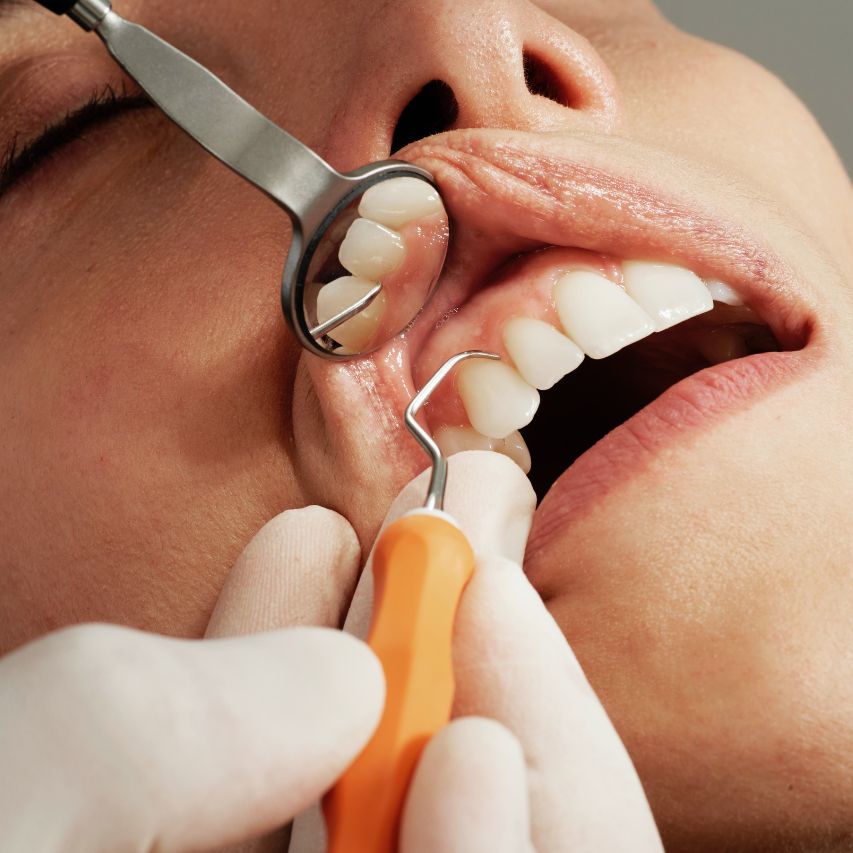“Gingivitis” refers to the earliest form of gum disease. “Periodontitis” usually refers to later stages of gum disease. “Periodontal disease” is a direct synonym of gum disease, referring to all stages, but its use is generally reserved for the more severe stages as a contrast to gingivitis.
More than half of US adults deal with gingivitis or periodontitis, but it can typically be treated with good oral hygiene.
What do the different names mean?
- “Gingiv-”is a prefix which refers to the gums in your mouth.
- “Perio-”is a prefix which means “around”, and “-don-”refers to the teeth, similar to the “den-” in “dentist”. Therefore, “periodon-” means “around the teeth” which refers to the gums (gingiva) and the surrounding structure supporting the gums (periodontium).
How can you tell the difference between gingivitis and periodontitis?Gingivitis causes swollen and bleeding gums. On the other hand, periodontitis is characterized by severely receding gums and deep pockets between teeth. Gingivitis is reversible, but periodontitis is so advanced that it may lead to tooth loss.
If you need a holistic dentist to treat your gum disease or check for the warning signs of periodontitis, visit Rejuvenation Dentistry in Manhattan or East Hampton.
Gingivitis
Gingivitis is a common, mild form of gum disease. Symptoms include sensitive and bleeding gums.
More than 3 in 4 adults have experienced gingivitis in their life, and more than half have some form of gum disease right now.
Untreated gingivitis may progress into periodontitis.
How long does it take for gingivitis to turn into periodontitis?Depending on your oral health and other factors, it can take weeks, months, or years for gingivitis to turn into more severe periodontitis. In the average person, it takes over a year for untreated gingivitis to progress to the next stage of gum disease.
Periodontitis
Periodontitis is a less common, more severe form of gum disease. Gum recession and loose teeth may result from periodontitis.
This condition is sometimes broken up into multiple stages:
- Initial or early periodontitis (stage I)
- Moderate periodontitis (stage II)
- Advanced periodontitis (stages III and IV)
Periodontitis may occur as a progression of untreated gingivitis.
Signs of Gingivitis
The warning signs of gingivitis (early gum disease) include the following:
- Receding gums
- Swollen, puffy gums
- Sore, tender gums
- Dark red gums
- Bleeding gums, especially after brushing or flossing
- Bad breath (halitosis)
Signs of Periodontitis
The symptoms of periodontitis (severe gum disease) include the following:
- Red or discolored gums
- Swollen, puffy gums
- Bleeding gums, especially after brushing or flossing
- Advanced gum recession
- Abscess along the gum line
- Sensitive teeth
- Pain when chewing
- Constant bad breath (halitosis)
- New gaps between the teeth
- Loose teeth
- Bone loss around your teeth and jaws
- Changes in tooth structure
- Changes in the fit of dental devices
Cause of Gum Disease
What are the most common causes of gingivitis?Poor oral hygiene is the most common cause of gum disease. However, there are multiple risk factors that can increase your chances of developing all stages of gum disease.
Poor oral hygiene and diet lead to bacteria and plaque buildup getting under your gum line and turning to tartar (calculus), which is difficult to clean. This plaque and tartar cause inflammation of the gum line, leading to swollen and bleeding gums.
What is the difference between plaque and calculus?Plaque is a buildup of bacteria and food debris; you can remove plaque with a toothbrush and floss. If not cleaned off your teeth, minerals in your saliva harden plaque buildup and turn it into calculus (AKA tartar), which is much harder to remove.
Remember — Do not try to clean tartar at home. A non-professional cleaning will likely result in an inconsistent clean, as well as damaged tooth enamel. Seek a deep cleaning from a dental hygienist.
Risk Factors
Multiple risk factors increase your chances of getting gum disease:
- Tooth decay (cavities)
- Poor oral hygiene habits
- Poor nutrition
- Injury to gums
- Dental cavitations
- Tooth extractions
- Chronic stress
- Tobacco
- Nicotine
- Vaping, which dries out the mouth
- Medications which affect saliva production, causing dry mouth
- Mouth breathing, especially when sleeping
- Type 2 diabetes
- Heart disease
- Immune system conditions, such as HIV/AIDS
- Hormonal changes in women, especially during pregnancy or menopause
- Older age
- Obesity
- Family history of gum disease
- Genetic disorders
Treatment Options
Treatments for gingivitis and periodontitis include:
- Good oral hygiene:For the early stages of gum disease, you can reverse gingivitis with better oral hygiene. Brushing your teeth with gentle circles angled towards your gums should keep most plaque from lingering beneath your gum line. At first, brushing and flossing may increase inflammation, but proper oral hygiene should lead to decreased inflammation and swelling within a few days.
- Scaling:Dental scaling addresses gingivitis and periodontitis. Scaling is when a dental professional removes plaque and tartar from below the gum line using manual tools or laser dentistry. The use of lasers is a more precise way to target hard and soft tissues affected by gum disease.
- Root planing:Root planing is similar to scaling, but the focus is on the roots of your teeth well below the gum line. To treat more advanced periodontitis, your dentist will use a tool to safely expose the roots of your teeth and chip away at bacteria and tartar buildup.
- Ozone dental treatments:Ozone gas, ozonated water, or ozonated oil can help kill harmful bacteria in the mouth. This method is safe and effective in treating gingivitis or periodontitis, with the added benefit of reducing tooth sensitivity.
- Tissue grafts:People experiencing advanced periodontitis may require soft tissue grafts if the roots of your teeth are exposed by receding gums. Dental professionals often use tissue from the roof of your mouth to surgically replace gum tissue, for a more natural appearance.
- Bone grafting:Some individuals with more severe forms of gum disease require surgical bone grafts to reverse bone loss from advanced periodontitis. These grafts allow for healthy regrowth and help maintain existing tooth structure.
- Guided tissue regeneration:This cutting-edge procedure allows for bone and tissue regrowth caused by gum infection. Your dentist places a biocompatible membrane between the bone and your tooth, which helps restore bone and healthy gum tissue.
- Platelet-rich plasma (PRP):PRP shows promise as an effective way to regenerate bone and tissue lost to severe cases of periodontitis. A dental professional will use injections of platelet-rich plasma from your own blood to stimulate growth in impacted areas.
- Pinhole surgical technique:This alternative to gum grafting involves pinholes in gum tissue adjacent to impacted areas. A dental professional will loosen the surrounding gums to cover receding areas and treat stages I and II of periodontitis. This method allows for faster healing and a more natural smile.
There are a few at home remedies for gingivitis and gum disease:
- Coconut oil pulling
- Salt water rinse
- Baking soda
- Lemongrass mouth rinse
- Tea tree oil mouthwash
- Green tea
Preventing Gum Disease
Here are 6 science-backed ways to support gum health and prevent gum disease:
- Brush your teeth twice per day.Motion your brush with gentle circles angled at 45° towards your gum line. Don’t brush right after a meal, so as to avoid rubbing acids into your teeth and weakening your dental enamel.
- Use a natural toothpastelike Revitin, the world’s first prebiotic toothpaste for a healthy oral microbiome.
- Floss every day.Flossing is your best defense against plaque which settles at the gum line in between teeth. If you spot any bleeding during your flossing routine, you may have identified warning signs of gingivitis.
- Don’t smoke or chew tobacco.Tobacco users have a much higher risk of developing periodontal disease. Smoking also reduces the success rate of periodontal treatments in more advanced cases. Vaping or e-cigarettes can also promote gum disease by increasing the chance of dry mouth.
- Maintain a healthy diet. Eat foods that reduce inflammation and give your body an antioxidant boost. Avoiding sugar and other carbohydrates can slow the progression of tooth decay and gingivitis by starving bad bacteria on your teeth of the carbs they crave.
- Keep regular dental visits.Visit your dentist twice a year for dental cleanings and preventative checkups. Schedule appointments more often if you require periodontal maintenance or if you’re at a high-risk for gum disease.
When to See a Dentist
You should see a dentist at least once a year (preferably more) for a professional cleaning and prevention screenings. If you notice early signs of gingivitis or are high-risk for developing periodontal disease, visit your dentist more frequently.
At Rejuvenation Dentistry, we support New York patients with minimally-invasive dental treatments backed by cutting-edge research. We help patients reverse their gingivitis and restore their healthy smile.
Ready to take control of your oral health? Schedule your appointment with Rejuvenation Dentistry today!
To learn more about our approach to overall health through the mouth, check out The Mouth-Body Connection, a book from the founder of our practice, Dr. Gerry Curatola.




